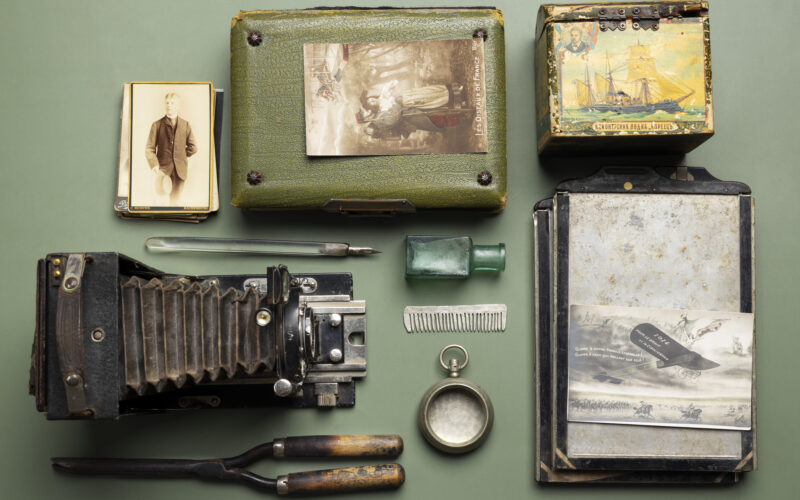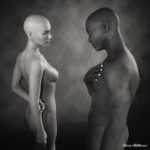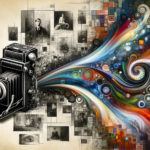Introduction:
In the contemporary artistic landscape, photography has long held an ambiguous position. Since its invention in the 19th century, it has sparked debates and controversies, swinging between acceptance as an art form and delegitimization as a mere technical tool. In this brief essay, we will explore the issue from various angles, with the aim of unveiling the multiple facets of this fascinating medium.
Photography as Art: Challenging Conventions
Since its birth in the 19th century, photography has fought for legitimacy in the realm of art. Many disputed its place among the fine arts, considering it merely as a means of recording the real world, emphasizing its technological aspect at the expense of its artistic value. After all, the image was “captured” by a machine, not “created” by a human hand. However, to reduce photography to a simple mechanism for reproducing reality would be a grave mistake.
Photography, like any other art form, requires artistic sensitivity and a creative vision. It’s not just about framing and shooting, but about seeing, about perceiving the world in a unique and personal way. The photographer manipulates reality, makes conscious choices about composition, lighting, angle, exposure time, and many other variables that determine the final appearance of the image.
Take, for example, Ansel Adams, one of the most renowned landscape photographers. Adams did not merely photograph nature; he interpreted it through his lens. He employed complex exposure and development techniques, known as the Zone System, to manipulate contrast and detail in his images, turning real landscapes into emotive and dramatic visions. His photographs are not just documents of places but representations of his personal relationship with nature.
Or consider Henri Cartier-Bresson, the father of photojournalism, who elevated photography to an art form capable of capturing the ephemeral essence of everyday life. With his concept of the “decisive moment,” he taught that the instant a photo is taken can make the difference between an ordinary image and an extraordinary photograph. For Cartier-Bresson, photography was an art form that required not only technical skill but also acute intuition and a perfect sense of timing.
Therefore, photography is not just about technology, but also about art. It is not just the product of a machine, but the result of the vision, sensitivity, and creativity of the artist who uses that machine as a tool to express their interpretation of the world.
Photography: An Art Medium That Captures the Essence of Reality
Photography, in its most pure and essential act, is the capture of the real world. Its unmatched precision in capturing reality has been both a blessing and a curse: a blessing, because it has allowed for the faithful documentation of reality; a curse, because this innate truthfulness has led many to devalue photography as an art form, considering it devoid of the imagination and creativity required by the fine arts.
However, to confine photography to merely a documentary tool is deeply reductive. Yes, photography can capture reality with a detail and precision no other artistic medium can match. But that does not mean it lacks artistic depth or is incapable of conveying emotions and stories. On the contrary, its affinity with the real can make it an incredibly powerful medium for expressing the complexity of the human condition.
Take Diane Arbus, for example. Arbus is renowned for her penetrating portraits of society’s outliers: dwarfs, giants, trans individuals, circus freaks. Her photographs are much more than mere documents of unusual or marginalized individuals; they are intense psychological explorations that reveal the depth of human experience. Arbus did not just “take” her photographs; she entered the lives of the people she photographed, spent time with them, creating a connection that reflected in the emotional intensity of her images.
Or consider Richard Avedon, one of the most prominent fashion photographers and portraitists of the twentieth century. Avedon revolutionized fashion photography, turning it from a simple representation of clothing into an art form capable of expressing ideas and emotions. But it is in his portraits that his talent for capturing the emotional essence of the subject is most apparent. His black and white photographs of both famous faces and unknowns are extraordinarily intimate and revealing, showcasing the vulnerability, strength, joy, sadness, complexity of the people he photographed.
It thus becomes clear that photography possesses a dual nature: it is simultaneously a tool for the documentation of the real world and a means of artistic expression capable of capturing the emotional essence of subjects. Despite appearances, photography is not solely about truth, but also about interpretation; it represents not just an image of the world, but a reflection on the artist who creates that image.
Photography: Merely Mechanical or Genuinely Artistic?
The technical nature of photography has prompted questions since its inception. How can a process that involves the use of a machine to capture images of the real world be classified as art? Can it really be placed on the same level as artistic disciplines such as painting and sculpture, which require the artist’s direct manual intervention?
In this section, we aim to answer these questions by examining the multiple artistic dimensions of photography. Despite its mechanical nature, photography is not a passive process. On the contrary, it requires a series of artistic and technical decisions, both during the composition of the image and in the post-production phase.
The choice of subject, framing, composition, focus, aperture, shutter speed, and ISO sensitivity are just some of the variables that the photographer must consider when capturing an image. And this does not take into account the infinite possibilities offered by post-production, where the photographer can modify the image through cropping, adjusting contrast, color saturation, and many other tools.
Ultimately, even though photography involves the use of a machine, we argue that it is not a mere mechanical process, but an artistic medium that requires a high degree of intuition, creativity, and technical skill.
La Fotografia come Arte: La Bellezza è nell'Occhio del Fotografo
In many ways, photography shares the same spirit that animates painting and sculpture: the intention to create an image that conveys not just a physical representation, but also an emotional and psychological narrative. In the act of taking a photograph, the photographer must make a series of crucial choices that will influence the meaning and impact of the image. These choices range from the selection of the subject to the composition of the image, from the lighting technique to the post-production process.
Consider, for example, nude photography. In the artistic tradition, the nude has been a fundamental subject of study, used to explore the human form in all its manifestations. As in painting and sculpture, in nude photography, the choice of subject can lead to significant emotional and social implications. A nude can be young or old, male or female, child or teenager, and each of these choices evokes a different emotional and social landscape.
Technical choices are equally important. The transition from black and white to color can radically transform the image, just as the use of shadows and lights can alter the perception of shape. Post-production also plays a crucial role: with the skilled use of editing techniques, the photographer can make the image more abstract or more realistic, more erotic or more chaste.
In the choice of the subject and in the execution of the photograph, the photographer is not just an operator of a camera, but an artist expressing his personal vision. This section explores in depth how photography, like any other art form, is a tool for communicating ideas, emotions, and perceptions. Through the art of photography, the photographer has the power to transform reality into a personal and artistic expression.
Conclusion:
After reviewing all the evidence, the statement that photography is an art form not only acknowledges the skill and creativity required to create exceptional images but also elevates photography as a powerful means of expressing emotions, ideas, and visions. Photography is not merely a device to capture the essence of reality; it is also a tool through which we can bring our dreams to life, transform reality, or even invent a new one. Therefore, the next time you pick up your camera, remember that you hold in your hands not just an advanced technological instrument, but an extraordinary artistic medium, rich with endless possibilities for expression.












